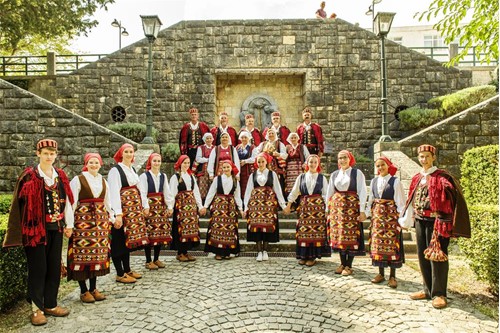THE DINARIC-ADRIATIC BLEND
Even though this region covers a relatively small geographical area, it is very rich in folklore and every settlement in the region is distinctive. The entire folklore can however be divided in the two main topographical types, the Adriatic and the Dinaric. They have been significantly influencing each other, but there have also been visible differences between the more urban (the Adriatic) and the more rural customs (the Dinaric) of the local people. The Adriatic folklore includes the town of Šibenik, a great part of the coastal settlements and the settlements of the islands, whereas the Dinaric folklore is mainly associated with the settlements of the hinterland and some settlements of the coast, formed due to migration from the hinterland. These differences, as well as the characteristics of each settlement, make for a great treasure within the county's overall folklore expression.
LOCAL DANCES
The old "Šibensko kolo" (circle), a traditional folk dance of Šibenik's inhabitants, is certainly worth mentioning, as some historians and chronologists consider it to be the Early Christian traditional dance that was the base for developing all other dances of that kind in the area and beyond. The dance has been nicely revived by the cultural association "Šibenske šuštine". The way of dancing and holding hands on the level of shoulders is especially interesting, as dancers are putting them up and down in the rhythm of the music, similar to very soft forward rowing movements. It is also important to mention the "Croatian Promenade", a traditional dance made up of five parts and 15 figures, first introduced as the dance of various national associations at the end of the 19th and the beginning of the 20th century. The promenade has been danced in Šibenik, the majority of the settlements along the county coast and on the islands, and it has even spread out to some coastal places of Zadar County.
LOCAL SONGS
Old Illyrian melodies, mostly sang by women in traditional ballads, have been preserved on the islands of this area. In the hinterland, on the other hand, the characteristically loud folk songs called "ojkalice" are performed. The whole area, especially the town of Šibenik, is also well-known for male a cappella groups called "klape". The inhabitants of Šibenik, especially those of the quarter Dolac, have been particularly renowned as one of the best singers in entire Dalmatia. There is even a verse in one old ballad about the coastal places and the islands of Dalmatia saying: "There is no singer but the man from Dolac... ".
LOCAL ATTIRE
The traditional clothing of this area is certainly something to be admired. No matter how hard you try, you won't find the same clothes even in two neighbouring settlements. The characteristic of the traditional female clothes from Primošten to Tribunj is a skirt with braces, while on the island of Murter and in Pirovac there are distinctive skirts with embroidered shirtfront. The female traditional costumes in the hinterland include white weaved skirts and shirts and multi-coloured aprons. Men in the coastal areas and on the islands also wear silk bands, while typical bands in the hinterland are either knitted or weaved with wool. One of the most recognized items of local clothing is a characteristically red cap, proudly used by the men of this area since the Middle Age. The other indispensable parts of male attire are the Šibenik buttons, beautiful decorations made of silver filigree for buttoning a stitched waistcoat (krožet), whose motif is also found in female jewellery, as much as the red coral of Zlarin.



